Turfgrass managers are concerned about zoysiagrass (Zoysia japonica Steud.) injury from nonselective herbicide treatment during winter dormancy. Research was conducted to assess factors affecting spray penetration into semidormant ‘Meyer’ zoysiagrass canopies and to evaluate absorption and translocation of [14C]glyphosate and [14C]glufosinate into green leaves and subtending stolons. Absorption of [14C]glyphosate and [14C]glufosinate was up to four times greater in stolons than in leaves. Zoysiagrass leaves treated with [14C]glufosinate had more rapid 14C absorption than those treated with [14C]glyphosate. More 14C translocated out of the treated area following [14C]glyphosate treatment compared with [14C]glufosinate and moved more readily from stolon to leaves than from leaves to stolon. When extended-range, flat-fan spray tips (XR) were positioned 61 cm above zoysiagrass, 73% and 11% of recovered colorant was extracted from dormant vegetation in the upper and lower canopy levels. Turbo TeeJet® spray tips (TTI) deposited fewer droplets into the upper canopy and more droplets into the middle and lower canopy regardless of position above the turf surface. Increasing pressure from 103 to 414 kPa increased droplet velocities from XR and TTI nozzles and decreased droplet diameters of XR nozzles. Droplet diameters were also substantially increased when using TTI nozzles compared with XR nozzles. Droplet diameter and associated mass were more determinant of turfgrass canopy penetration than droplet velocity. At 60 L ha–1 of carrier volume, 23% of colorant reached the lower canopy level, and this quantity increased by 2.3% per additional 100 L ha–1. When carrier volume was reduced from 584 to 60 L ha–1, 48% less colorant was delivered to the lower canopy level. Given that subcanopy stolons are always present and absorb more glyphosate and glufosinate than leaves, practices such as avoiding induction-type nozzles, raising spray height, and reducing spray volume can reduce herbicide delivery and potential injury to semidormant zoysiagrass.
How to translate text using browser tools
17 November 2023
Factors Influencing Subcanopy Leaf and Stolon Exposure and Associated Absorption and Translocation of Herbicides in Semidormant Zoysiagrass
Jordan M. Craft,
Navdeep Godara,
Clebson G. Gonçalves,
Shawn D. Askew
ACCESS THE FULL ARTICLE

Weed Science
Vol. 72 • No. 1
January 2024
Vol. 72 • No. 1
January 2024
Canopy penetration
post-dormancy transition
spray droplets





